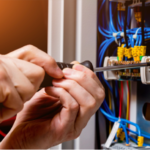Domestic Electrical Installation
Wiring your home allows the power to be used to run things like appliances, lights, and computers. A domestic electrician runs the wires through the walls and installs a breaker box to connect the home to an outside power source.
During the process of installation, all electrical wiring is tested to ensure that everything functions properly. This includes installing fans, switch boards and receptacles as well as HVAC systems.
Wiring
The wiring of a home electrical installation is the conduit for electricity to different parts of the home, such as lights, home electrical installation appliances, and receptacles. Because it can be hazardous and costly to make a mistake wiring is an essential component of any electrical work.
There are a variety of types of wiring. The type that you choose will be determined by the goal you’re trying achieve. You’ll require wire that can withstand the high currents if you’re installing outlets.
The exposure of the wires to sunlight, oil, and other chemicals is another factor to consider. These factors could influence the insulation quality and electrical rating of the wire.
A common electrical system includes three wires: a black or «hot» wire, neutral (or white) wire, and grounded copper wire. These wires are protected from each other with colored sheathing. The sheathing also indicates the gauge and number of each wire.
Once the wires are ready, you can begin connecting them and creating the circuit. You’ll need to decide how many switches and receptacles you’ll require, as well the locations they’ll be placed.
Then, connect the wires to the main electrical panel of your home. It could be on the ground floor, in garage or utility.
The wiring inside your home is controlled by a number of codes that are both national and local. These codes are essential to be aware of and follow to avoid hazards that could be dangerous.
Switches
Switches are a critical part of any electrical system. When you install a light switch or a circuit breaker the devices are designed to break and create the current flowing through an electrical circuit.
It is possible to use simple or complex switches within your home. It is important to choose switches that are compatible with the circuit you’re working with.
There are a variety of switches to choose from, including single-pole, dual-pole, and three-way. Some have unique features, like a timer that lights automatically when motion is detected in the room.
Toggle switches are the most commonly used type of switch that is used in home wiring. They have a latch design which means they remain in place until the lever is pushed in a different direction.
They are available in a variety of sizes and electrical ratings. They are usually used in lighting control switches.
A single-pole toggle has two hot brass screw terminals and an earth wire connection to connect to the circuit’s ground. The switch also features an «traveler» with an adjustable hotwire that connects to the screw terminals that are common to all.
The traveler is always hot, therefore it’s crucial to wrap a standard wire around it prior to wiring it to the switch. This will prevent many headaches later.
The contacts in switches have to be resistant to abrasion and friction which is caused by sliding of the contacts. This is especially important for switches that run continuously. The friction and abrasion can cause physical damage to contacts in switches, such as melting or deformation of contacts themselves made of metal. The friction and abrasion may also decrease the lifespan of the switch itself.
Breakers
When a breaker is shut off it prevents electricity from flowing through the circuit until it is fixed. This prevents electrical equipment malfunctions, fires, and other safety hazards that could otherwise happen if electricity is not properly controlled.
Breakers are an essential part of a niceic domestic installer electrical installation. Without them, your home is without power.
A breaker is an electric switch that cuts off the connection between circuit contacts as current flows through them. It can be reset by flipping the switch back to its original position , and restarting the circuit.
A breaker can either be single-pole (protecting one wire) or double pole (protecting two wires). A single-pole breaker is ideal for smaller household circuits and a double-pole breaker is suited for larger appliances and other large loads.
Some breakers can be enhanced by adding additional functions, such as the detection of arc faults. This detects electrical conductors in wires caused by rodent bites, damaged insulation, or any other cause. They can also be integrated into smart homes and connected to the Internet.
 Installing breakers should be done in accordance with the panel’s amp rating. The amp ratings range from 60 amps for older homes up to 200 AMPS in new construction.
Installing breakers should be done in accordance with the panel’s amp rating. The amp ratings range from 60 amps for older homes up to 200 AMPS in new construction.
To determine the amount of breakers required for your electrical installation, you should consult an electrician who is licensed. This will ensure that you’re using the right ones to meet your needs and your system is running smoothly.
In addition to protecting your home from overcurrent and short circuits, breakers also aid in reducing energy costs. Smart breakers are able to connect to the Internet to track your energy usage and adjust in real-time to save the cost of your electric bill.
Panel Upgrades
The heart of the electrical system that runs through your home is the electrical panel. It is responsible for distributing the electric power to all the rooms of your house from outlets and lights to appliances. A faulty or insecure electrical panel could lead to serious problems, such as fires.
If you’ve noticed breakers that are frequently tripping, or if your lights flash a lot it could be time to upgrade your panel. You might also hear crackling noises from an old panel that indicates that it’s not able to take the current electricity flowing through it.
Another symptom of an outdated panel is a constant need to flip breakers. This could indicate that your circuits have been overloaded, or the breakers in your system are not working and require replacement.
It is important to know that electrical work can be hazardous and should be left to experts. This is especially true for upgrading your home. An electrician with the right qualifications and experience is the best.
Your home will benefit from upgrading your electrical panel. It improves safety, reduces the possibility of electrical fires, and may even boost the value of your home’s resales.
In addition, upgrading your electric panel can help reduce your electric bills and boost the efficiency of your energy use. This will help you save money over the long run, and it can also aid in getting a lower insurance premium for your home.
Electrical Safety
Although electricity is an essential aspect of modern life but it can also pose danger if not properly handled. In reality, electrical fires are responsible for an estimated 51,000 fires in residential properties each year in the United States alone, with defective wiring and other electrical equipment as the primary cause.
This can result in serious injuries and deaths. Electrical safety measures can decrease the risk of home fires.
First, workers must be aware of how electricity works , and what precautions to take when working with electricity. This includes knowing the details of the job, observing safety guidelines and using PPE correctly. Regular inspections are also necessary.
It is also crucial to ensure that electrically powered equipment is properly grounded. This is a vital security measure that stops the circulation of electricity through a person instead of the equipment that could cause injury.
In addition, workers must be able to distinguish between live and de-energized elements of electric equipment. They must confirm that all parts of their equipment are de-energized prior to they begin working on them, and then re-energize any live parts prior to when they leave the workplace.
Workers who come into contact with live electrical equipment must immediately disconnect it. Employees must be sure to keep their hands, eyes and feet from any electrically energized components and at least 30 inches away from them when working on them.
If a worker isn’t sure whether they’re safe working with electricity, they should seek out an expert with experience for guidance. They can assist them assess the risks of exposure to electricity, determine a safe distance and suggest appropriate protective clothing.



